

Vol. 40 (Number 6) Year 2019. Page 11
Inderpal SINGH 1; Anand NAYYAR 2; Subhankar DAS 3
Received: 10/08/2018 • Approved: 21/01/2019 • Published 18/02/2019
3. Objectives & research methodology
ABSTRACT: Loyalty revolves around the concept of relationship. Customer loyalty is not a new concept but recent years have demonstrated a developing interest to fabricate customer loyalty because of customer-oriented techniques or strategies. Over the previous era, customer loyalty has been broadly inspected inside marketing, trades and transaction-based literature (e.g. Reynolds & Arnold, 2000; Lam et al., 2004; Palmatier et al., 2007). The literature suggests that customer loyalty is an important driver of business performance. Customer loyalty has been linked to business performance, organizational success, profit, and cost (Baldauf et al., 2003; Liang et al., 2009). Loyal customers are willing to pay more, express higher buying intentions and resist switching (Evanschitzky et al., 2012). The current study is focused on identifying and describing the relationship between antecedents and consequences of customer loyalty in the Indian context, taking a sample of individual customers as respondents from the Indian State of Punjab. This study contributes to the customer relationship management and services marketing literature by providing empirical support for customer loyalty and business performance relationship in the Indian context. |
RESUMO: A lealdade gira em torno do conceito de relacionamento. A lealdade do cliente não é um conceito novo, mas os últimos anos demonstraram um interesse crescente em fabricar a lealdade do cliente por causa de técnicas ou estratégias orientadas para o cliente. Durante a era anterior, a fidelidade do cliente foi amplamente inspecionada em marketing, negociações e literatura baseada em transações (por exemplo, Reynolds & Arnold, 2000; Lam et al., 2004; Palmatier et al., 2007). A literatura sugere que a lealdade do cliente é um importante impulsionador do desempenho dos negócios. A lealdade do cliente tem sido associada ao desempenho do negócio, sucesso organizacional, lucro e custo (Baldauf et al., 2003; Liang et al., 2009). Os clientes fiéis estão dispostos a pagar mais, expressar intenções de compra mais altas e resistir à troca (Evanschitzky et al., 2012). O presente estudo está focado em identificar e descrever a relação entre antecedentes e conseqüências da lealdade do cliente no contexto indiano, tomando uma amostra de clientes individuais como respondentes do estado indiano de Punjab. Este estudo contribui para a gestão de relacionamento com o cliente e literatura de marketing de serviços, fornecendo suporte empírico para a lealdade do cliente e relacionamento de desempenho de negócios no contexto indiano. |
Loyalty revolves around the concept of relationship. Customer loyalty is not a new concept but recent years have demonstrated a developing interest to fabricate customer loyalty because of customer-oriented techniques or strategies.
Over the previous era, customer loyalty has been broadly inspected inside marketing, trades and transaction-based literature (e.g. Reynolds & Arnold, 2000; Lam, Shankar, Erramilli & Murthy, 2004; Palmatier, Scheer & Steenkamp, 2007).
The literature suggests that customer loyalty is an important driver of business performance. Customer loyalty has been shown to improve exchange relationships (Oliver, 1999), increase advocacy or word-of-mouth (Reichheld & Sasser, 1990; Dick & Basu, 1994; Reynolds & Beatty, 1999; Shoemaker & Lewis, 1999; Srinivasan, Anderson & Ponnavolu, 2002; Reichheld, 2003; Lam et al., 2004; Luo & Homburg, 2007; Eisingerich & Bell, 2007; Casalo, Flavian & Guinaliu, 2008; Akbari, Kazemi & Haddadi, 2016), increase repurchase intention (Law, Hui & Zhao, 2004; Eisingerich & Bell, 2007; Power & Valentine, 2008), positive behavioral intention (Zeithaml, Berry & Parasuraman, 1996; Bolton, Kannan & Bramlett, 2000), increase price (Reichheld & Sasser, 1990; Zeithaml et al., 1996; Aaker, 1996; Srinivasan et al., 2002; Palmatier et al., 2007; Evanschitzky, Ramaseshan, Woisetschlager, Richelsen, Blut & Backhaus, 2012), increase profits (Keiningham, Cooil, Aksoy, Andreassen & Weiner, 2007; Palmatier et al., 2007), increase share of wallet (Jones & Sasser, 1995; Dowling & Uncles, 1997; Coyles & Gokey, 2005; Lam & Burton, 2006; Palmatier, Dant, Grewal & Evans, 2006; Meyer-Waarden, 2007; Keiningham et al., 2007; Wirtz, Mattila & Lwin, 2007; Evanschitzky et al., 2012; Keiningham, Cooil, Malthouse, Lariviere, Buoye, Aksoy & De Keyser, 2015; Srivastava & Kaul, 2016), & increase overall financial performance (Sirdeshmukh, Singh & Sabol, 2002). Customer loyalty is a hidden force and it is not easily identifiable. There is a challenge to the marketers to know the essential factors which influence customer loyalty and their effects. Research has identified main antecedents of customer loyalty viz. customer satisfaction, commitment, trust, and image. The more loyal the customers, the longer the relationships; which accelerate sales, generate a positive intention, price premium and profits to the supplier. Positive word-of-mouth, repurchase intention, price premium and share-of-wallet are the likely consequences of customer loyalty.
India has a broadened, diversified and expanded financial service sector experiencing quick development, in existing finance related services firms as well as new elements entering the market. This financial segment contains insurance agencies, mutual funds, commercial banks, non-banking financial organizations, co-operatives, public funds, pension funds, capital market and other monetary benefits derived from small organizations. Commercial banks represent more than 60 percent of the aggregate resources held by the financial system in India.
According to IBEF (2017a), “The Indian banking system consists of 27 public sector banks, 26 private sector banks, 46 foreign banks, 56 regional rural banks, 1,574 urban cooperative banks and 93,913 rural cooperative banks, in addition to cooperative credit institutions. Public-sector banks control more than 70 percent of the banking system assets, thereby leaving a comparatively smaller share for its private peers. ICRA estimates that credit growth in India´s banking sector would be at 7-8 percent in FY 2017-18”.
According to IBEF (2017b), “The insurance industry of India consists of 57 insurance companies of which 24 are in life insurance business and 33 are non-life insurers. Among the life insurers, Life Insurance Corporation (LIC) is the sole public sector company. The number of lives covered under health insurance policies during 2015-16 was 36 crore which is approximately 30 percent of India's total population. The number has seen an increase every subsequent year as 28.80 crore people had the policy in the previous fiscal. During June 2016 to May 2017 period, the life insurance industry recorded a new premium income of Rs. 1.87 trillion (US$ 29.03 billion). The life insurance industry reported 9 percent increase in the overall annual premium equivalent in April-November 2016”.
Figure 1.1
Number of Life Insurance Firms in India

Source: https://www.irdai.gov.in
With the support of structured banking and insurance system, today, India is one of the most alive or vibrant global economies. Indian Financial Sector isn't just a key factor of strength in the worldwide economy, but also a source of massive financial opportunity for the world. Many foreign companies in a joint venture with Indian companies have announced their stakes enhancing plans. This all happens due to entry barrier relaxation of foreign investment. Over the coming years, a series of the joint venture can be seen between global financial players with the domestic players. In the insurance sector, the insurance penetration ratio is also having a probability to cross over 4% in the coming years as of now is less than 3.5%. Investment corpus in Indian insurance sector can rise to USD1 trillion by 2025.
The current study is focused on identifying and describing the relationship between antecedents and consequences of customer loyalty in the Indian context, taking a sample of individual customers as respondents from the Indian State of Punjab. The study tests the following conceptual model:
Figure 1.2
Conceptualized Model of Antecedents and Consequences of Customer Loyalty

This study contributes to the customer relationship management and services marketing literature by providing empirical support for customer loyalty and business performance relationship in the Indian context.
Yi and Jeon (2003), stated that behavioral loyalty is reflected as particular brand’s purchase frequency and the possibility of repurchase. Behavioral loyalty is reflected by “depth of repeat” i.e. repurchase of the items twice, thrice and many times; which ultimately enhances their engagement with the same firm (Fourt & Woodlock, 1960, Baum & Dennis, 1961; Eskin, 1973; Kalwani & Silk 1980; Ehrenberg, 1988; Kahn, Kalwani & Morrison, 1988; Fader & Hardie, 1996; Griffin & Herres, 2002; Evanschitzky, Iyer, Plassmann, Niessing, & Meffert, 2006; Matzler et al., 2006; Wilkins, 2010).
Kandampully & Suhartanto, 2000; Wang, 2010; Allaway et al., 2011; Kandampully et al.,2015 in light of the fact that the variables prompting customer loyalty may be critical elements for an organization’s sustainability and intensity (Berezan, Raab, Yoo & Love, 2013). This endeavor is to give a general picture of how to achieve customer loyalty and reveal dormant connections among its antecedents.
Cant and Toit (2012) define loyal customer as, “one who has an emotional attachment to an organization, acts positively towards the organization by purchasing repeatedly from the organization over a certain period of time and recommends the organization to others including friends and colleagues. Loyal customers can, therefore, be said to be important to the organization as both a source of revenue and a marketing tool for recommending the organization”.
Indian economy is growing consistently. Especially the services sector in India is growing by leaps and bounds (Dasgupta & Singh, 2005; Panda, 2009). The services sector contributes about 60% of country’s GDP. There is need to understand and investigate the factors that could enhance customer loyalty in the financial service industry in the Indian context. It is incumbent upon the academics and practitioners alike to investigate the strategies to increase customer loyalty. The rapid growth, increased competition, rising non-performing assets (NPA) problem and unstable organizational performance in service sector calls for investigation of the customer loyalty. The literature suggests that customer loyalty is an important driver of business performance. However, studies reveal different opinion regarding antecedents of customer loyalty. The relationship between customer loyalty and business performance models has been conceptualized and tested predominantly in the developed economies and a little has been explored in the context of developing economies. While this concept is all around vital, it is particularly important in the developing economies. There is hardly any examination conducted for investigating the connection between customer loyalty and business performance in an Indian setting. Research is required to explore and identify the determinants of customer loyalty, specifically for the financial services firms in India. The extent to which various factors influence the performance outcomes is also not well known for the Indian financial services sector. There is a need for studies to address these research gaps. The present study is an attempt to fill these gaps.
The research aimed at studying the following objectives:
1) To measure customer loyalty in the financial service sector in Punjab.
2) To study the relationship between customer loyalty and business performance in the Banking & Insurance Service Sector of Punjab.
3) To study the relationship between the antecedents (customer satisfaction, commitment, trust, and image) and the consequences (word-of-mouth, repurchase intention, price premium, and share of wallet) of customer loyalty in the Banking & Insurance Service Sector of Punjab.
The study has been conducted in the State of Punjab (India). Five major cities i.e. Amritsar, Jalandhar, Ludhiana, Patiala and the Union Territory of Chandigarh representing the state of Punjab have been studied. The banking firms and the life insurance firms from the public sector as well as the private sector have been studied as representatives of the financial service sector. The individual customers have been taken as respondents to represent each of the banking firm and the insurance firm.
A purposive sample of 600 respondents was taken. The individual bank/insurance customers have been taken as respondents to represent each of the banking firm and the insurance firm. The selection of bank/insurance customer was based on two criteria viz. (i) he/she must be active and in a relationship with the firm for over one year, and (ii) he/she must not be an employee of the firm. Out of the 600 questionnaires distributed to the customers of banking and life insurance firms as per above plan, 553 were received back. 66 questionnaires were found to be incomplete and inconsistent. These responses were not reckoned for data analysis. Hence, 487 unique responses were used for final data analysis. The sample is representative enough of the financial service sector of Punjab. Out of 487 respondents, 323 were from the banking industry and 164 were from the insurance industry. 64.68% firms belonged to the public sector and the private sector firms comprised 35.32% of the total sample. The sample gave good representation to both male and female customers. Out of 487 respondents, 266(54.6%) were male and 221 (45.4%) were female respondents. There were 252 (51.7%) married respondents and the rest were single (48.3%).
Survey method of data collection has been applied using a self-developed structured questionnaire for the study. A systematic procedure has been adopted for the development of the research instrument. Firstly, various constructs of interest (e.g. customer loyalty, switching cost, complaint handling and business performance etc.) were specified and an item pool was generated, based on a review of the literature. The item pool was examined and relevant items were selected to operationalize various constructs.
To study the customer loyalty in the financial service sector, exploratory and descriptive research has been used. Exploratory research was undertaken to understand customer loyalty phenomenon and to identify the antecedents and consequences of customer loyalty based on a review of the extant literature. Descriptive research portrays the data and characteristics about the phenomenon being examined. This research design was chosen as the current study focuses on identifying the causal relationships related to customer loyalty.
The collected data has been analyzed using uni-variate, bi-variate, and multivariate analysis techniques. Specifically, descriptive statistics have been assessed to examine the basic characteristics of the sample data. Confirmatory factor analysis (CFA) with maximum likelihood criteria has been adopted for the measurement and validation of various constructs. Independent samples t-test has been used to compare the customer loyalty of public and private firms, banks and insurance firms, and for some of the demographic variables like gender, marital status etc. One-way ANOVA has been used to compare the customer loyalty for variables having more than two groups. Structural Equation Modeling (SEM) has been used to measure the impact of customer loyalty on the business performance of financial services firms. Moderation Analysis has been adopted for measuring the impact of switching cost and complaint handling on customer satisfaction and customer loyalty relationship. In addition to Microsoft Excel, the software packages SPSS 19.0 and AMOS 19.0 were used for computerized data analysis.
Customer loyalty (CL) is a higher order construct with customer satisfaction (CS), commitment (C), trust (T) and image (CI) as its dimensions. Customer loyalty is measured as a latent variable having customer satisfaction, commitment, trust and image as its dimensions as shown in Figure 4.1
Figure 4.1
Customer Loyalty Scale
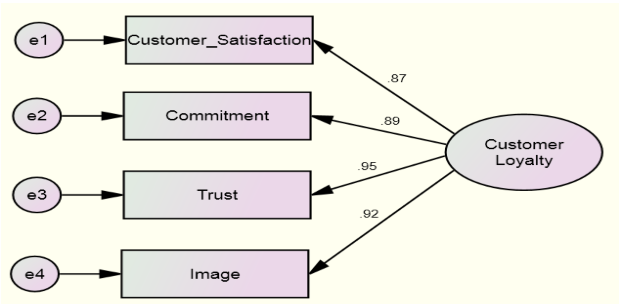
In the next level, multi-dimensionality of customer loyalty (CL) has been checked using the confirmatory factor analysis (CFA). The values of RMR (0.004), GFI (0.987), AGFI (0.936), and CFI (0.994) were above the threshold level as indicated in the Model-I of Table 1.1. But values of RMSEA (0.109) and normed chi-square were not within acceptable range. A few modification indices were found between error terms e2 and e4. A covariance has been applied between e2 to e4 as shown in Figure 1. 4 A revised higher order construct model has been initiated.
Table 4.1
Model Fit Indices of Customer Loyalty Scale
CFA Default Model |
RMR
|
GFI
|
AGFI |
CFI
|
RMSEA
|
χ2
|
Df
|
p-Value
|
χ2/df
|
I |
.004 |
.987 |
.936 |
.994 |
0.109 |
13.460 |
2 |
0.001 |
6.730 |
II |
0.001
|
1.000
|
0.997
|
1.000
|
0.000
|
0.317
|
1 |
0.574
|
0.317
|
The CFA was again used to approve the client reliability scale, reflected in wording of four constructs identified, i.e., customer satisfaction (CS), commitment (C), trust (T) and Image (CI). A revised model emerged as shown in Figure 1.4
Figure 4.2.
Validated Customer Loyalty Scale
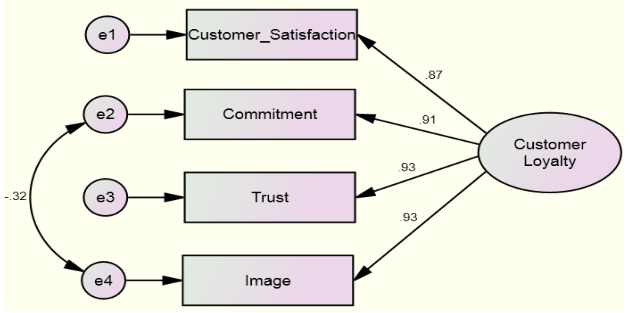
The results of a reconsidered multi-dimensional model of customer loyalty reveal a good model fit. The goodness of fit indices (GOF) viz. GFI, AGFI, and CFI were above the threshold level of .90, the badness of fit indices (BOF) i.e. RMR and RMSEA were on the edge of 0.00 as shown in Table 4.8. The Normed Chi-square has a value of 0.317. The Standardized factor loadings were in the range of 0.868 to 0.934 as shown in Table 4.2 which is far above the threshold limit of 0.50.
Table 4.2
Psychometric Properties of Customer Loyalty Scale
Construct
|
Parameter
|
Index
|
Dimension
|
Std. Factor Loadings |
AVE
|
CR
|
Customer Loyalty
|
Chi-square |
0.317 |
Customer Satisfaction |
0.868 |
0.829
|
0.951
|
Degree of Freedom |
1.000 |
|||||
Normal Chi-square |
0.317 |
Commitment |
0.906 |
|||
GFI |
1.000 |
|||||
AGFI |
0.997 |
Trust |
0.933 |
|||
CFI |
1.000 |
|||||
RMR |
0.001 |
Image
|
0.934
|
|||
RMSEA |
0.000 |
An AVE score of 0.829 indicates that the diverse dimensions of customer loyalty construct unite on the underlying theoretical idea of customer loyalty. CR of 0.951 underpins the high positive relationship between the distinctive dimensions of customer loyalty and demonstrates their inward consistency. Table 4.2 discloses positive and noteworthy relationship coefficients among customer satisfaction, commitment, trust and image i.e. various dimensions of customer loyalty and supports the multidimensional conceptualization of customer loyalty construct.
In light of the above confirmations, customer loyalty can be considered as a higher order latent variable.
Business Performance (BP) is a higher order construct with word-of-mouth (WOM), repurchase intention (RI), price premium (PP) and share of wallet (SOW) as its indicators. Business performance (BP) is measured as a latent variable having word-of-mouth, repurchase intention, price premium and share of wallet as its dimensions as shown in Figure 4.3.
Figure 4.3
Business Performance Scale
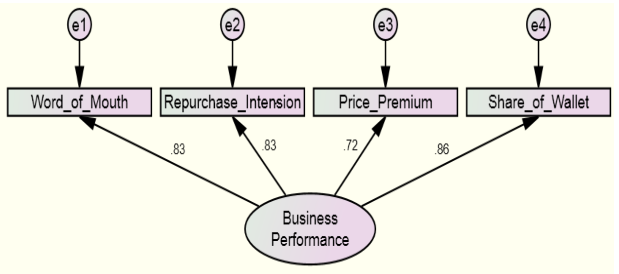
In the next stage, multi-dimensionality of Business performance was checked by applying confirmatory factor analysis (CFA). The model indicated a poor fit as shown in the CFA default Model-I of Table 1.3. The goodness of fit indices viz. GFI=0.991, AGFI=0.957, CFI=0.994 was near or above the threshold limit of 0.9. The badness of fit indices RMR and RMSEA have been reported as 0.006 and 0.079 respectively, which were within the acceptable range. But due to high normed chi-square value, a few modification indices have been noticed between error terms e3 to e4. A covariance has been used between e3 to e4 as shown in Figure 1.6
Table 4.3
Model Fit Indices of Business Performance Scale
CFA Default Model |
RMR
|
GFI
|
AGFI |
CFI
|
RMSEA
|
χ2
|
Df
|
p-Value
|
χ2/df
|
I |
0.006
|
.0.991 |
0.957
|
0.994 |
0.079
|
8.064
|
2 |
0.018
|
4.032
|
II |
0.001
|
1.000
|
0.999
|
1.000
|
0.000
|
0.102
|
1 |
0.749
|
0.102 |
Multi-dimensionality of Business performance (BP) has been checked using the CFA. The model indicated good model fit. The CFA was again used to authenticate the scale of business performance, replicated in terms of four constructs identified, i.e., word-of-mouth (WOM), repurchase intention (RI), price premium (PP) and share of wallet (SOW). A revised model emerged as shown in Figure 4.4.
Figure 4.4
Validated Business Performance Scale
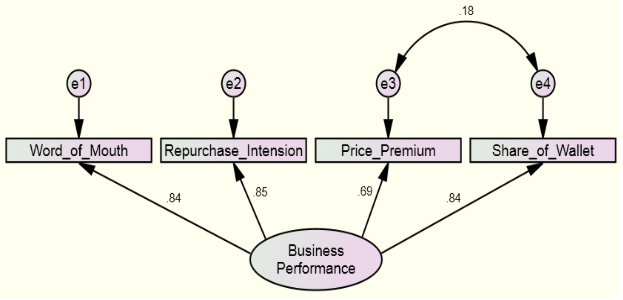
The results of a multi-dimensional model of business performance reveal a good fit. The criteria of goodness of fit (GOF) viz. GFI, AGFI, and CFI were above the threshold limit of .90, badness of fit indices (BOF) i.e. RMR and REMSA were at the edge of 0.00, as shown in Table 4.4. The value of normal Chi-square i.e. 0.102 has been noticed. The Standardized factor loadings were in the range of 0.69 to 0.85 which is above the threshold limit of 0.50.
Table 4.4
Psychometric Properties of Business Performance scale
Construct
|
Parameter
|
Index
|
Dimension
|
Std. Factor Loadings |
AVE
|
CR
|
Customer Loyalty
|
Chi-square |
0.102 |
Word of Mouth |
0.843 |
0.654
|
0.883
|
Degree of Freedom |
1.000 |
|||||
Normal Chi-square |
0.102 |
Repurchase Intention |
0.847 |
|||
GFI |
1.000 |
|||||
AGFI |
0.999 |
Price Premium |
0.692 |
|||
CFI |
1.000 |
|||||
RMR |
0.001 |
Share of Wallet
|
0.843
|
|||
RMSEA |
0.000 |
An AVE with 0.654 indicates that the diverse dimensions of business performance construct converge on the underlying theoretical concept of business performance. CR of 0.883 underpins the high positive relationship between the distinctive dimensions of business performance and demonstrates their inward consistency. In light of the above confirmations, business performance can be considered as a higher order latent variable. Hence, Business performance is a higher-order construct measured in terms of word-of-mouth, repurchase intention, price premium, and share of wallet has been supported.
Table 4.5
Industry-wise customer loyalty in financial service sector in Punjab
Factors |
Industry
|
N |
Mean |
Standard Deviation |
Std. Error Mean |
t-test |
Sig. |
Customer Loyalty
|
Banking |
323 |
2.8793
|
.51170
|
.02847
|
-1.101
|
.272
|
Insurance |
164 |
2.9439
|
.65674
|
05128
|
|||
Customer Satisfaction
|
Banking |
323 |
3.0323
|
61961
|
.03448
|
-.978
|
.329
|
Insurance |
164 |
3.0945
|
.74077
|
.05784 |
|||
Commitment
|
Banking |
323 |
3.4297
|
.70140
|
.03903
|
-1.420
|
157
|
Insurance |
164 |
3.5395
|
.85511
|
.06677
|
|||
Trust
|
Banking |
323 |
2.9460
|
56106
|
03122
|
-1.504
|
.134
|
Insurance |
164 |
3.0386
|
67952
|
.05306
|
|||
Image
|
Banking |
323 |
3.5063
|
65223
|
.03629
|
.488
|
.626
|
Insurance |
164 |
3.5420
|
81180
|
.06339
|
*Significant at 5% level
Table 4.5 shows that mean scores for banking and insurance firms is not significantly different at 95% level of confidence (p<0.05). The customer loyalty among the banking and insurance firms in Punjab is statistically not significantly different (p=0.272). The table also shows that banking and insurance firms are not significantly different for various dimensions of customer loyalty. Conclusively, there are no significant differences in scores for customer loyalty and its dimensions viz. customer satisfaction, commitment, trust and image within the industry.
Fig: 4.5
Industry-wise Average Customer Loyalty
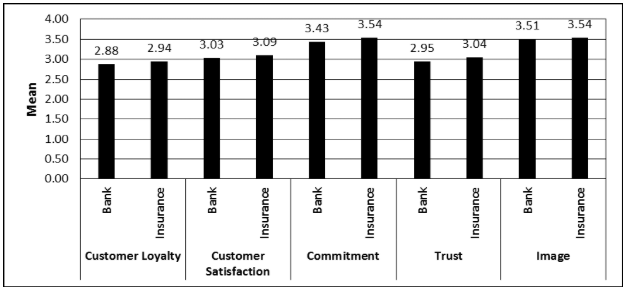
Figure 4.5 depicts the industry-wise mean comparison of the customer loyalty. Each dimension of customer loyalty has been shown for two types of firms i.e. banking and insurance firms. The insurance firms have the highest mean for customer loyalty. There were 323 and 164 respondents representing banking and insurance firms. The mean value for insurance firms was 2.94 which is higher than the mean value of banking firms i.e. 2.88 (See, Figure 1.9), but it is not significantly different statistically.
Figure 4.6 represents banking firm-wise mean comparison of customer loyalty. The ICICI and SBI banks have the highest mean for customer loyalty. The mean value for private sector bank is higher than the mean value of public sector bank (See, Figure 4.6).
Figure 4.6
Banking Firm-wise Average Customer Loyalty
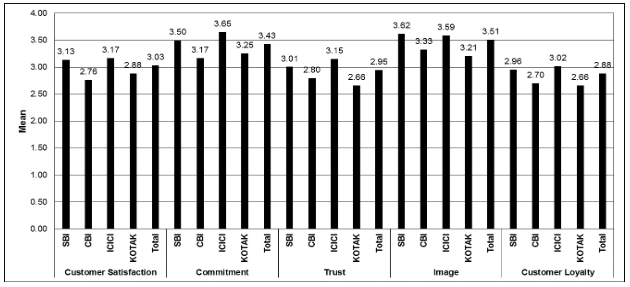
-----
Figure 4.7. depicts the insurance firm-wise mean comparison of customer loyalty. The LIC has the highest mean score for customer loyalty.
Figure 4.7
Insurance Firm-wise Average Customer Loyalty
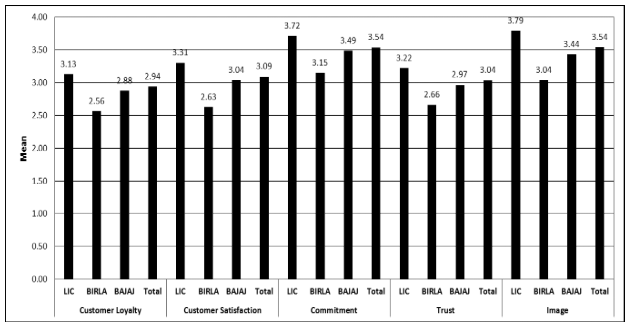
A two-stage procedure has been adopted to evaluate the relationship between customer loyalty (CL) and business performance (BP).
The first stage discusses the testing of measurement model and the second stage discusses the structural model for testing the casual relationship between the CL and BP. Structural equation modeling has been applied to check the multiple dependence relationships. SEM is preferred over multiple regressions because it helps in checking the dimensionality and validity of the constructs, combines the factor analysis and multiple regression, helps in studying the multi-group moderation as well as the effect of mediating variables. Instead of focusing on a single index, to evaluate the degree of model fit, confirmatory factor analysis (CFA) and structural equation models frequently depend upon various fit indices like: GFI, CFI, AGFI, RMSEA and RMR. Regression analysis is silent about these fit indices.
A model is an exemplification and operationalization of a particular theory. How consistently and logically different latent constructs are connected with each other is represent by measurement model (Joreskog & Sorbom, 1993). “A measurement model represents a theory, showing how measured variables come together to represent constructs. It specifies the rules of correspondence between measured and latent variables (constructs). The measurement model enables the researcher to use any number of variables for a single independent or dependent construct” (Hair et al., 2010). Measurement models are used to judge the worth of measurement of the items and related constructs. In the present study, a measurement model was used to check the covariance between the two constructs i.e., customer loyalty (CL) and business performance (BP) as shown in Figure 4.8. A two-headed arrow has been used for demonstrating the covariance between the measured variables. The measurement model was fitted to measure the convergent and divergent validity of constructs.
Fig. 4.8
Measurement Model for Customer Loyalty and Business Performance
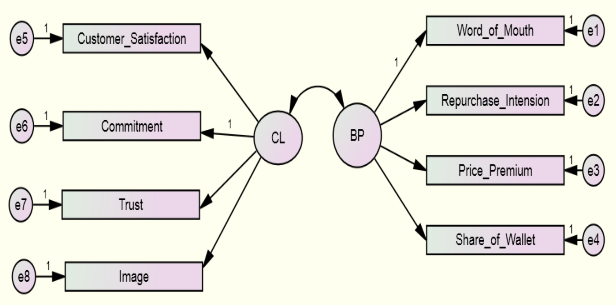
Displaying covariance arrow, a measurement model of customer loyalty and business performance has been exhibited in Figure 4.8. CFA Model-I revealed a poor fit model (RMR = 0.010, GFI = 0.939, AGFI = 0.884, CFI = 0.975, RMSEA = 0.104, χ2 = 118.340, df = 19, p = 0.000, χ2/df = 6.228), as shown in Table 4.6. A few modification indices were noticed after applying initial measurement model. Thus, in order to recognize the modification indices, covariances were applied and a revised CFA model was fitted, as shown in Figure 4.9
Table 4.6
Model fit Indices for Customer Loyalty and Business Performance (Measurement Model)
CFA Default Model |
RMR
|
GFI
|
AGFI |
CFI
|
RMSEA
|
χ2
|
Df
|
p-Value
|
χ2/df
|
I |
0.010
|
.0.939 |
0.884
|
0.975 |
0.104
|
118.340
|
19 |
0.000
|
6.228
|
II |
0.007
|
0.972
|
0.933
|
0.989
|
0.076
|
57.006
|
15 |
0.000
|
3.800 |
-----
Fig. 4.9
Validated Measurement Model for Customer Loyalty and Business Performance

The revised (CFA) model (RMR = 0.007, GFI = 0.972, AGFI = 0.933, CFI = 0.989, RMSEA = 0.076, χ2 = 57.006, df = 15, p = 0.000, χ2/df = 3.800) indicates a good fit, as shown in Table 4.6.
The validity of customer loyalty (CL) and business performance (BP) constructs were verified using AVE, CR and discriminant validity as recommended by Fornell and Larcker (1981).
In the next stage, to test the relationship between customer loyalty (CL) and business performance (BP), a structural model was fitted. A model is said to be a structural model when it inspects the causal relationship among constructs (Joreskog & Sorbom, 1993; Ullman, 2001). “The structural model applies the structural theory by specifying which constructs are related to each other and the nature of each relationship. The structural model shows how constructs are associated with each other, often with multiple dependence relationships. The model can be formalized in a path diagram” (Hair et al., 2010).
Structural equation modeling has been used to assess the causal relationship between the customer loyalty and business performance.
Fig. 4.10
Validated Structural Model for CL and BP
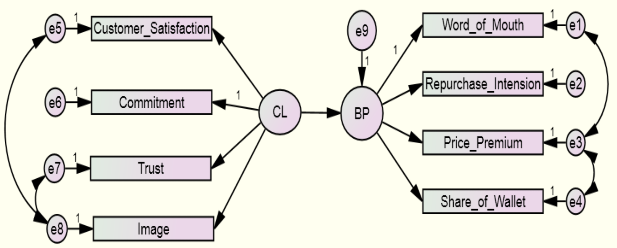
Fig. 4.10 represents a path diagram, in which customer loyalty has been considered as an exogenous (independent) variable and business performance as an endogenous (dependent) variable and the basic relationship between these two constructs has been reflected through a solitary headed bolt or arrow on path chart. Whereas, this relationship was checked in the measurement model with the help of two-headed arrow.
The model fit indices for structural equation modelling (SEM) suggested a good model fit as shown in Table 4.7.
Table 4.7
Structural Equation Modelling (SEM)
CFA Default Model |
RMR
|
GFI
|
AGFI |
CFI
|
RMSEA
|
χ2
|
Df
|
p-Value
|
χ2/df
|
I |
0.007
|
.0.972 |
0.933
|
0.989 |
0.076
|
57.006
|
15 |
0.000
|
3.800
|
Further, the measurement model and structural model was compared with their psychometric properties, as shown in Table 4.8. It was observed that there was no reduction in the psychometric properties when we moved from prior model to the later model i.e. MM to SEM, which shows the fitness of basic model. For SEM the properties of the fitness indices i.e. GFI, AGFI, CFI have been found above the threshold limit. Similarly, the psychometric properties of the badness of fit i.e. RMR and RMSEA are under the threshold limit.
Table 4.8
Comparison of Model Fit Indices
Parameter |
Measurement Model |
Structure Equation Model |
Chi-square |
57.006 |
57.006 |
Degree of Freedom |
15 |
15 |
Normal Chi Square |
3.800 |
3.800 |
GFI |
0.972 |
0.972 |
AGFI |
0.933 |
0.933 |
CFI |
0.989 |
0.989 |
RMR |
0.007 |
0.007 |
REMSA |
0.076 |
0.076 |
Thus, the results of the path analysis indicate a good model fit. The strength of the significant relationship between customer loyalty and business performance was very good i.e. 0.98.
Therefore, it can be concluded that the customer loyalty (CL) significantly influences business performance (BP).
1) The result shows that business performance is a higher-order construct measured in terms of word-of-mouth, repurchase intention, price premium and share of wallet.
2) Though each of the four measures of customer loyalty is special and unique in nature yet a high level of positive correlation has been seen among these dimensions
3) The study reveals that customer loyalty is not significantly different for the banking firms and insurance firms in Punjab.
4) There is a significant difference in the customer loyalty for public and private sector financial services firms in Punjab. The results show that customer loyalty is significantly different for three dimensions of customer loyalty (i.e. customer satisfaction, trust and image) in public and private financial firms in Punjab. However, the commitment is not significantly different on the basis of the sector.
5) Study finds that customer loyalty of banking firms is significantly different from each other with respect to the four dimensions of customer loyalty (i.e. customer satisfaction, commitment, trust and image).
6) There is a significant difference in the customer loyalty for insurance firms in the financial service sector in Punjab. The various dimensions of customer loyalty (i.e. customer satisfaction, commitment, trust and image) are significantly different from each other among the insurance firms.
7) The study finds a significant and positive relationship between customer loyalty (CL) and business performance (BP). Proposed model of CL/BP relationship has demonstrated that higher customer loyalty results in better business performance (BP).
8) Results show that word-of-mouth is not equally dependent upon customer loyalty dimensions viz. customer satisfaction, commitment, trust and image in financial services firms in Punjab. Various dimensions have their significant and unique role but trust is the best predictor of word-of-mouth.
9) The repurchase intention is not equally dependent upon customer loyalty dimensions in the financial service sector in Punjab. When combined effect of all the antecedents are measured only two predictors show their relative importance i.e. trust and commitment. The effect of other two predictors i.e. customer satisfaction and image on repurchase intention have been captured by trust and commitment.
10) The price premium is not equally dependent upon customer loyalty dimensions. Commitment is the strongest predictor of price premium followed by the trust of the customer.
This study examined the antecedents and consequences of customer loyalty with respect to the financial service sector in Punjab. It confirmed customer satisfaction, commitment, trust and image as antecedents of customer loyalty. Word-of-mouth, repurchase intentions, price premium and share of wallet were validated to be the consequences of customer loyalty. It also examined and confirmed the role of switching cost and complaint handling as moderators in CS-CL relationship.
The conceptual model hypothesized and validated in this study provides a rich agenda for further research. The model will hopefully, serve as a framework for further empirical research in the realm of customer loyalty and marketing performance measurement and management. Empirical research may be conducted in different service sectors and product markets to test the relationships about antecedents and consequences of customer loyalty. Future scholars, with a specific goal to explore the connection between customer loyalty and business performance, may test the directing or moderating impact of some other conceivable variables like demographic characteristics, the social angle of switching cost etc. The likelihood of intervening or mediating factors amongst customer loyalty and business performance relationship can be investigated. The outcomes of the study will help professionals and research scholars to build up a superior comprehension of the role of customer loyalty and its fruitful execution.
Aaker, D. A. (1996). Measuring brand equity across products and markets. California Management Review, 38(3), 102-120.
Abdullah, M., Al-Nasser, A. D., & Husain, N. (2000). Evaluating functional relationship between image, customer satisfaction and customer loyalty using general maximum entropy. Total Quality Management, 11(4/6), 826-829.
Adamson, I., Chan, K. M., & Handford, D. (2003). Relationship marketing: Customer commitment and trust as a strategy for the smaller Hong Kong corporate banking sector. International Journal of Bank Marketing, 21(6/7), 347-358.
Ahmed, I., Gul, S., Hayat, U., & Qasim, M. (2001). Service quality, service features and customer complaint handling as the major determinants of customer satisfaction in banking sector: A case study of national bank of Pakistan. Retrieved from ,www.wbiconpro.com/5%5b1%5d.ishfa.pdf accessed on January 14, 2017
Aiken, L. S., West, S. G., & Reno, R. R. (1991). Multiple Regression: Testing and Interpreting Interactions. Newbury Park, CA: Sage.
Akbari, M., Kazemi, R., & Haddadi, M. (2016). Relationship marketing and word-of-mouth communications: Examining the mediating role of customer loyalty. Marketing and Branding Research, 3(1), 63-74.
Allaway, A. W., Huddleston, P., Whipple, J., & Ellinger, A. E. (2011). Customer-based brand equity, equity drivers, and customer loyalty in the supermarket industry. Journal of Product & Brand Management, 20(3), 190-204.
Allen, N. J., & Meyer, J. P. (1990). The measurement and antecedents of affective, continuance and normative commitment to the organization. Journal of Occupational and Organizational Psychology, 63(1), 1-18.
Anderson, E. W. (1998). Customer satisfaction and word of mouth. Journal of Service Research, 1(1), 5-17.
Ba, S., & Pavlou, P. A. (2002). Evidence of the effect of trust building technology in electronic markets: Price premiums and buyer behavior. MIS Quarterly, 26(3), 243-268.
Bagozzi, R. P. (1975). Marketing as exchange. The Journal of Marketing, 39(4), 32-39.
Bagozzi, R. P., Yi, Y., & Phillips, L. W. (1991). Assessing construct validity in organizational research. Administrative Science Quarterly, 36(3), 421-458.
Cambra-Fierro, J., Melero-Polo, I., & Sese, F. J. (2016). Can complaint-handling efforts promote customer engagement? Service Business, 10(4), 847-866.
Campbell, D. T., & Fiske, D. W. (1959). Convergent and discriminant validation by the multi-trait-multi method matrix. Psychological Bulletin, 56(2), 81-105.
Day, E., Denton, L. L., & Hickner, J. A. (1988). Clients' selection and retention criteria: Some marketing implications for the small CPA firm. Journal of Professional Services Marketing, 3(3-4), 283-295.
Ehigie, B. O. (2006). Correlates of customer loyalty to their bank: A case study in Nigeria. International Journal of Bank Marketing, 24(7), 494-508.
Faed, A., Hussain, O. K., & Chang, E. (2014). A methodology to map customer complaints and measure customer satisfaction and loyalty. Service Oriented Computing and Applications, 8(1), 33-53.
Garbarino, E., & Johnson, M. S. (1999). The different roles of satisfaction, trust, and commitment in customer relationships. The Journal of Marketing, 63(2), 70-87.
Hair, J. F., Anderson, R. E., Tatham, R. L. and Black, W. C. (2010). Multivariate Data Analysis. (7th Edition). Englewood Cliffs, NJ: Prentice-Hall.
1. Associate Prof. KCLIMT Jalandhar, Punjab, India. arora_inderpal@yahoo.co.in
2. Professor. Graduate School, Duy Tan University, Da Nang, Vietnam. anandnayyar@duytan.edu.vn
3. Research Scholar in Faculty of Management Studies, IBCS. SoA (Siksha ‘O’ Anusandhan University), Bhubaneswar, India. info.subhankardas@gmail.com